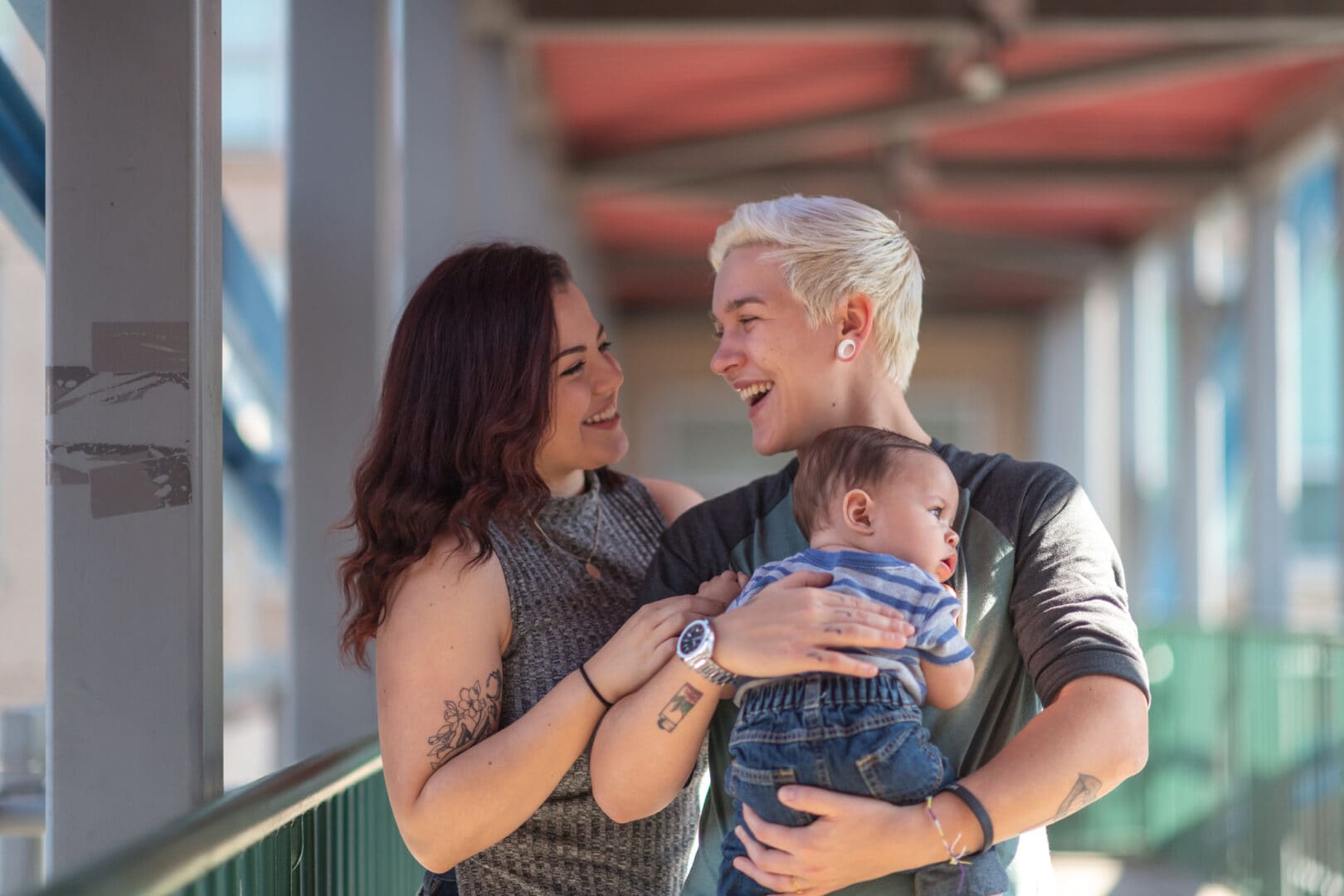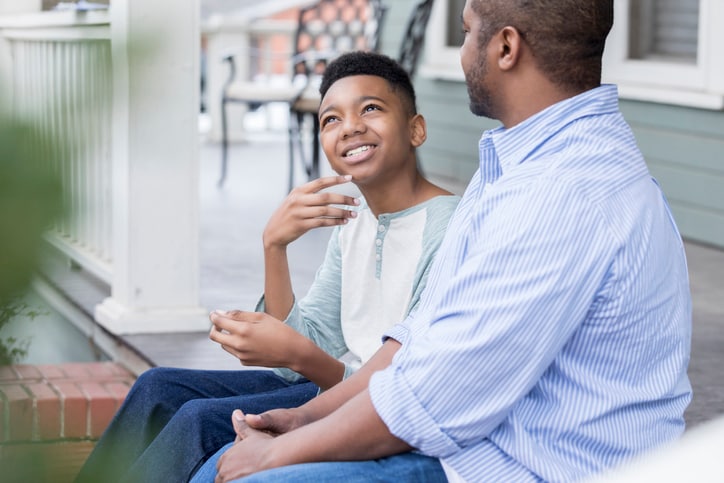In this article
- First, what is nonbinary?
- What are the different gender identity terms?
- When do people begin to figure out their gender identity?
- How to explain nonbinary gender identity to children
- How to discuss nonbinary gender with teens and adults
- What if you don’t know someone’s gender identity or pronouns?
- For more information:
Gender diversity has always existed throughout cultures around the world, but in recent years, it’s become a more prominent topic of conversation in our own society. Some individuals have long been aware that gender goes way beyond the binary — that is, that gender is a social construct involving the roles people play and present in society, and that while some folks identify as women or as men, others are neither gender, other genders, more than one gender or a gender other than the one they were assigned at birth. But it’s something others are only beginning to learn about.
As parents and caregivers, it’s important to be aware of the differences between different genders and gender expressions. Having and sharing this knowledge allows us to not only raise kids who are accepting of others but also ones who feel supported themselves. Here, we’re focusing on what it means to be nonbinary, how to explain nonbinary to a child early on and how to be a good ally to nonbinary folks.
Key takeaways
- Nonbinary means not identifying as exclusively male or female on the gender spectrum.
- The latest psychological research tells us that kids start to understand and categorize their own gender identity around age 3.
- There are many different terms to describe gender, sex and identity. Resources like The Trevor Project and the Human Rights Campaign can help you stay up-to-date.
First, what is nonbinary?
According to the Human Rights Campaign’s Glossary of Terms, being nonbinary can mean:
- Not identifying exclusively as a man or a woman, and
- Identifying as a man and woman, as somewhere in between or as somewhere outside of these categories.
“Gender has traditionally been constructed to be a choice between being male or female, but it is much more expansive than that,” says Dr. Myeshia Price, developmental psychologist and senior research scientist for The Trevor Project, the world’s largest suicide prevention and crisis intervention organization for LGBTQ youth. “Many other words exist for identities outside the binary as well, such as ‘genderfluid’ and ‘genderqueer.’”
What are the different gender identity terms?
While there is some overlap on gender identity terms, it’s important to understand that different individuals may use different terms (and some may use more than one label).
“The differences are definitely subtle,” says Lindz Amer, writer, performer, activist and creator of Queer Kid Stuff, a webseries that teaches young audiences about LGBTQIA+ matters. “Anyone who identifies as anything but as the two binary genders (no matter if they’re cisgender or transgender) probably identifies under the nonbinary umbrella.”
Amer says “genderqueer” is often used as an alternate term to nonbinary that is linguistically removed from the idea of a binary gender system, whereas “gender-nonconforming” is more about dismantling gender roles and stereotypes and can be used by someone who does not identify as nonbinary or genderqueer.
“Anyone who identifies as anything but as the two binary genders (no matter if they’re cisgender or transgender) probably identifies under the nonbinary umbrella.”
— Lindz Amer, writer, activist and creator, Queer Kid Stuff
Then there’s “genderfluid,” which according to Amer falls under the nonbinary/genderqueer umbrella. “Someone who is genderfluid might feel like their gender fluctuates within the gender spectrum, like they might feel more feminine one day and present in a more feminine way, but might feel more masculine another day and want to express themselves in a masculine way. It’s all about fluidity,” says Amer, who is currently writing a queer-affirming parenting book for St. Martin’s Press/Macmillan slated to publish this fall.
And then there’s the term “agender,” which Amer defines as someone who doesn’t feel like they fit within any gendered structures or spectrums.
“Someone who is agender might use neo (or new)-pronouns like ze/hir, fae, or per. An agender person might identify as nonbinary or genderqueer as well, but maybe not,” says Amer.
Quick glossary of gender identity terms*
| Nonbinary | Does not identify exclusively as male/a man or female/a woman; can also mean identifies as male and female, as somewhere in between or as somewhere outside of these categories. May or may not also identify as transgender. Can be used as an umbrella term for being gender-fluid, agender, bigender or genderqueer. |
| Genderqueer | Does not identify exclusively as male or female but uses this alternate term to nonbinary, which is linguistically removed from the idea of a binary gender system. |
| Gender-nonconforming | Does not identify exclusively as male or female, or as nonbinary or genderqueer, but uses this term, which dismantles gender roles and stereotypes. |
| Genderfluid | Does not identify exclusively as male or female but fluctuates within the gender spectrum. At any time, they may shift to identify and/or present as more feminine and more masculine in a fluid way. |
| Agender | Does not identify within any gendered structures or spectrums. |
| Transgender | Identifies as a gender other than the one they were assigned at birth. |
*Reminder: This terminology is constantly changing, so it’s always important to stay up-to-date by asking people about their gender identity terms.
When do people begin to figure out their gender identity?
Unfortunately, there are still some who don’t believe or understand that young children are capable of understanding things like gender identity, but science tells us otherwise.
According to Mayo Clinic, children begin to recognize stereotypical gender groups by the time they are 2 years old, and most already know how to categorize their own gender by age 3. But because gender stereotypes are often reinforced and even rewarded in our society, they say that some kids end up behaving in ways that counter their authentic gender identity.
Terri Laue, a nonbinary parent of a 10-year-old agender child, says it’s important to believe people when they tell you who they are. “Someone isn’t ‘too young’ to know their identity,” says Laue.
Additionally, the Connecticut-based parent says that even if being nonbinary ends up being “a phase.” that’s actually OK. “We all go through phases. Toddlerhood is a phase. Being a teenager is a phase. Every part of our lives is a phase in some way. That doesn’t make it any less valid or real. Don’t discount someone’s identity by telling them it’s ‘only a phase,’” says Laue.
Read more:
How to explain nonbinary gender identity to children
Amer says they always begin by explaining a simple definition of gender.
“Gender is a feeling,” says Amer. “There’s an internal feeling we all have that’s how we feel about ourselves and our gender identity, and we can express that gender feeling externally to the world through lots of different things: clothes, hair, hobbies, art, the list goes on and on.”
This can then lead into conversations about pronouns.
“We can also express ourselves and our gender through our pronouns. For kids, I explain that pronouns are words we use to replace someone’s name that indicate our gender in most languages,” says Amer. “Some people use she/her, he/him, or neo (new)-pronouns like ze/hir, or fae or per.”
From there, Amer might share that folks who use they/them pronouns (like themselves) usually identify as nonbinary.
Parents and caregivers should understand that it may take some children more time to understand these concepts initially if they haven’t been part of regular, ongoing household conversations. When Texas-based mom Toni G.’s middle child came out as nonbinary, she says her youngest child struggled initially with the change.
“He’s a black-and-white thinker,” says Toni, who took the time to research and educate herself more in order to support her nonbinary child. “(Eventually, my youngest) came around to not only being accepting but will now advocate for his sibling if someone uses the wrong pronouns.”
How to discuss nonbinary gender with teens and adults
Amer says they use a very similar explanation no matter the individual’s age, but might skip out the explanation of what a pronoun is with older individuals.
“Adults are taught that our gender is what a doctor puts on their birth certificate, and most adults never even think to question that,” Amer says. “So I put it in terms simple enough that a kid could understand it because, in many ways, adults are revisiting these ideas with a child-like perspective as a completely new conception of what gender is.”
With older individuals, Amer says it’s less about the definitions and explanations and more about answering questions and having a more open conversation.
“The only other thing I might get a little deeper into is explaining the binary gender system of boys and girls so that I can work with the adults to dismantle that system that’s been so ingrained in every day of their lives, so they can start to parse through it themselves,” says Amer.
What if you don’t know someone’s gender identity or pronouns?
“Just like we can’t assume someone’s name, we can’t assume someone’s pronouns,” says Price.
One tip she recommends is simply introducing yourself with your own pronouns when you meet someone new, which can then give the other person the opportunity to share theirs. “When in doubt, just ask!” she says.
“Just like we can’t assume someone’s name, we can’t assume someone’s pronouns.”
— Dr. Myeshia Price, developmental psychologist and senior research scientist for The Trevor Project
Moreover, Price explains that respecting a nonbinary young person’s pronouns isn’t just the right thing to do, but that it can potentially be lifesaving. The Trevor Project’s research has found that nonbinary youth who reported that ‘no one’ respected their pronouns had more than 2.5x the rate of attempting suicide compared to those who reported that ‘all or most of the people’ they know respected their pronouns,” says Price. She also shares that a recent study found that over the past year, nonbinary youth who found acceptance from at least one adult in their lives had 33% lower odds of attempting suicide than those who were not accepted.
For more information:
Check out these books and links, and keep an eye out for more articles on raising and supporting the nonbinary children in our lives
Books about gender identity for kids, teens and adults
For children:
- “It Feels Good To Be Yourself: A Book About Gender Identity” by Theresa Thorn.
- “The Gender Wheel: A Story About Bodies and Gender for Every Body” by Maya Christina Gonzales.
- “Peanut Goes for the Gold” by Jonathan Van Ness.
For teens:
- “A Quick & Easy Guide to They/Them Pronouns (Quick & Easy Guides)” by Archie Bongiovanni.
For adults:
- “Beyond the Gender Binary” By Alok Vaid-Menon.
- “The Gender Creative Child: Pathways for Nurturing and Supporting Children Who Live Outside Gender Boxes” by Diane Ehrensaft PhD.




